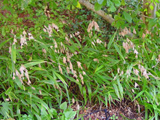Native Plants

Q. Who is Mr. Smarty Plants?
A: There are those who suspect Wildflower Center volunteers are the culpable and capable culprits. Yet, others think staff members play some, albeit small, role. You can torture us with your plant questions, but we will never reveal the Green Guru's secret identity.
Did you know you can access the Native Plant Information Network with your web-enabled smartphone?
Ask Mr. Smarty Plants is a free service provided by the staff and volunteers at the Lady Bird Johnson Wildflower Center.

rate this answer
Saturday - January 05, 2008
From: San Antonio, TX
Region: Southwest
Topic: Grasses or Grass-like
Title: Post freeze care for Texas native grasses
Answered by: Barbara Medford
QUESTION:
Can you tell me the best post-freeze care for Tx native grasses in my garden: lindheimer muhly, gulf muhly, inland sea oats. Mexican feather grass. Do I cut them back? Burn them? Leave them alone? Thank you.ANSWER:
The key word in your question is "native." When you select plants that are already adapted to an area, it cuts down on the maintenance that has to be done. Muhlenbergia lindheimeri (Lindheimer's muhly), Muhlenbergia capillaris (hairawn muhly), Chasmanthium latifolium (Inland sea oats), and Nassella tenuissima (finestem needlegrass) are all native to this area, and will suffer little, if any, from frost. With all grasses, the main concern in trimming is keeping them tidy. It's probably best to leave any dead stems on the grasses until the chances of frost are well over, as the overhanging grasses will help to protect the green part of the plant from an excessive freeze. Then, you might cut about 1/3 of the plant back, and thoroughly rake out any dead or cut ends. Keeping the dead grasses out of the plants is important both to appearance and because the dry material can be a burn hazard. Obviously, we do not advise that you burn anything, especially now with the dry weather in Central Texas, along with high winds.
More Grasses or Grass-like Questions
Mowable grass to grow under pecan trees in Houston, Texas.
September 07, 2010 - I read your answer on grasses that will grow under pecans, but Iím looking for a grass that will blend in a bit with the rest of our St. Augustine grass yard. Something I can mow. Our pecan trees are ...
view the full question and answer
Native grasses for medians in Colorado Springs
June 11, 2010 - Our city has stopped watering our historic landscaped medians due to severe budget shortfalls. The medians were historically tree boulevards but have had curb and gutter and blue grass added over th...
view the full question and answer
Perennial ground cover for hillside in Holmdel NJ
April 25, 2014 - I live in NJ. I would like to use a perennial ground cover for my landscaping bed on a hill with full sun and deer resistant. It's a good size landscaping bed that is facing east (southeast).
What...
view the full question and answer
Keeping non-native invasive bermudagrass out of yard in Austin
May 30, 2012 - My neighbor just sodded a huge lawn with Bermuda Celebration. I don't want it coming into my St. Augustine. From what I've read on your site and others, I need a deep barrier. Has anyone tried pu...
view the full question and answer
Survival of native lawn in Hockley TX
August 02, 2011 - I'm on the edge of the Katy Prairie and a very large ranch with full blasting sun and completely open exposure. The soil is fill from the developers with more clay than sand, a minimum of nutrients,...
view the full question and answer
| Support the Wildflower Center by Donating Online or Becoming a Member today. |

